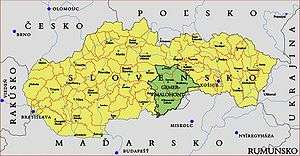Gemer
Gömör (Slovak: Gemer, Hungarian: Gömör, German: Gemer or Gömör, Latin: Gömörinum) was an administrative county (comitatus) of the Kingdom of Hungary. In the 19th century, and in the beginning of the 20th century, it was united with the Kishont region (in Slovak: Malohont) to form Gömör-Kishont county (in Slovak: Gemer-Malohont). Its territory is now in southern Slovakia and northern Hungary. Today Gömör is only an informal designation of the corresponding territory.
- The article is about the historical region: for the village in Slovakia, see Gemer (village).

Geography
Gömör county was situated in Slovenské rudohorie approximately between the present-day Slovak-Hungarian border, the towns Poltár and Rožňava and the Low Tatras (Nízke Tatry). The river Sajó flowed through the county. Its area was 4,289 km² around 1910.
Capitals
The capital of Gömör was the Gemer Castle/Gömör, and from the early 18th century Plešivec/Pelsőc. The capital after the addition of Malohont/Kishont was Rimavská Sobota/Rimaszombat.
History
Gömör is one of the oldest counties of the Kingdom of Hungary, and was already mentioned in the 11th century. The territory approximately between the towns Tisovec and Rimavská Sobota, called Kishont/Malohont, was added from 1786 until 1790, and again in 1802. The county was called Gömör-Kishont/Gemer-Malohont since. She was also ruled by Ottomans between 1553-1686 as part of Nograd and Holok sanjaks in Buda and Uyvar eyalets.
In 1918 (confirmed by the Treaty of Trianon 1920), most of the county became part of newly formed Czechoslovakia, except 7,5% of its area (around Putnok), which became temporarily part of the Hungarian county Borsod-Gömör-Kishont (presently part of Borsod-Abaúj-Zemplén).
The Czechoslovakian part of the county was part of the Slovak Land (Slovenská krajina/zem). During World War II, when Czechoslovakia was split temporarily, most of the county became part of Hungary under the First Vienna Award, and the Gömör-Kishont County was recreated. This situation lasted until the end of the war, when 92.5% of the area became part of Czechoslovakia again. Today in Hungary the name of Gömör/Gemer preserved only in the name of a small village, Gömörszőlős, the Gömör Museum in Putnok, and in that of Gömöri station, the smaller railway station of Miskolc.
Since 1993, when Czechoslovakia was split, Gemer and Malohont became part of Slovakia's Banská Bystrica Region.